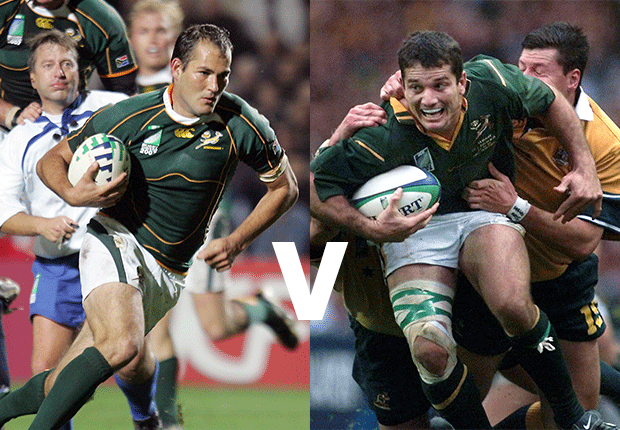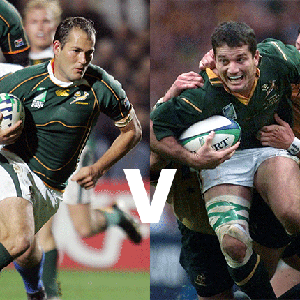|
Fourie du Preez and Joost van der Westhuizen |
When Sport24’s Herman Mostert recently penned his greatest Springbok team of the professional era, one of the major talking points highlighted by you, the rugby public, concerned the scrumhalf position.
Register your interest for the British & Irish Lions tickets in South Africa 2021
Fourie du Preez was picked at scrumhalf, but a number of Sport24’s readers in reaction suggested they would’ve opted for 1995 Rugby World Cup winner Joost van der Westhuizen.
The quality of both Bulls legends cannot be questioned, but Sport24 felt it would be a good idea to make a case for the inclusion of both in the starting XV.
Herman Mostert again makes a case for Du Preez to start, while editor Garrin Lambley backs Van der Westhuizen.
But what do YOU think? Joost or Fourie? Let us know your thoughts by mailing us on [email protected] or by tweeting us @Sport24news.



CASE FOR: Fourie du Preez
You have to be pretty darn good to eclipse the great-late Joost van der Westhuizen, but in my view Fourie du Preez’s tactical genius gives him the nod at scrumhalf.
The Bulls were lucky to boast arguably the country’s two greatest scrumhalves in consecutive eras.
Van der Westhuizen was a better all-round rugby player – he was exceptionally quick for a No 9 (he did operate on the wing a few times) and possessed unmatched athleticism during his prime.
However, for me, Du Preez was a better all-round scrumhalf.
Du Preez was a key cog in the victorious Bulls Super Rugby outfits of 2007, 2009 and 2010, as well as the Springboks’ 2007 World Cup triumph – his performance in the 36-0 group stage win over England will go down as perhaps the finest ever from a scrumhalf on the Test stage.
Other highlights for Du Preez included the 2009 British & Irish Lions series triumph and the 2004 and 2009 Tri-Nations campaigns. His trophy cabinet is a bit more storied than Van der Westhuizen’s.
But the one thing that made Du Preez great – and what set him apart from other contemporaries – was his calmness under pressure.
Tactically, he was also the best scrumhalf of his era.
Kicking is a vital weapon in a scrumhalf’s armoury and there was no greater exponent of this art than Du Preez.
As was the case with Van der Westhuizen, Du Preez was quite big for a scrumhalf – 1.82m and 90kg – yet you could never blame him for slow service behind the engine room.
The sign of a good player is always one who appears to have a lot of time under pressure and Du Preez was exactly that.
Both Du Preez and Van der Westhuizen were class acts, but I would utilise the latter as an impact player from the bench in my ‘all-time Springbok XV’.
CASE FOR: Joost van der Westhuizen
There’s little debate that the Springboks have been blessed in the scrumhalf department with two of the world’s premier No 9s in recent decades.
Between Joost van der Westhuizen and his successor Fourie du Preez, the Springboks boasted a distinct advantage over the opponents in the years 1993 to 2015.
The argument as to ‘who was better’ between the pair will rage for years to come, but for me, for the mere fact that he revolutionised the role of a No 9, Joost gets the nod.
Van der Westhuizen burst onto the international stage as a 22-year-old in 1993. Standing 6-foot-2, he was noticeably bigger than his direct opponents and could hold his own at ruck/maul time and didn’t take a backward step when carrying out tackles on rampaging forwards – and backs.
This was never more evident than in the 1995 Rugby World Cup final when Van der Westhuizen’s now famous tackle on All Blacks great Jonah Lomu went a long way to instilling belief in his team-mates that the New Zealand juggernaut (and team and Lomu in particular) could be toppled.
Van der Westhuizen would go on to play in three World Cups for the Springboks, becoming the first Springbok to do so when he was named in the 2003 squad.
In addition to his formidable size, Van der Westhuizen’s blinding pace set him apart from any other No 9 in the world at the time. In 89 Tests for the Springboks, he scored a staggering 38 tries. Nearly 17 years after his retirement, that figure remains the second most by a Springbok – in any position – and the most by any scrumhalf to have played the game.
A one-team servant of the Blue Bulls, Van der Westhuizen ran out on 71 Super Rugby occasions for the Pretoria-based franchise. In addition, he led the side to the 1998 Currie Cup title and was an integral part of the victorious Springboks Tri-Nations squad that same year.
Van der Westhuizen was recognised for his on-field heroics when he was inducted into the International Rugby Hall of Fame in 2007, and in 2015 became a member of the World Rugby Hall of Fame when the International Hall was merged with it.
In 2001 Van der Westhuizen became the first player to play 100 matches for the Springboks (Tests and tour matches) and was entrusted with the Test captaincy on 10 occasions.
Van der Westhuizen was diagnosed with Motor Neuron Disease in 2011. As was the case during his playing career, Van der Westhuizen fought the crippling ailment for nearly six year with fierce tenacity and intestinal fortitude.
Tragically he lost the battle a fortnight before his 46th birthday. There wasn’t a dry eye in the stadium at his public memorial service at his beloved Loftus Versfeld.
RIP Joost … and thanks for the memories.


